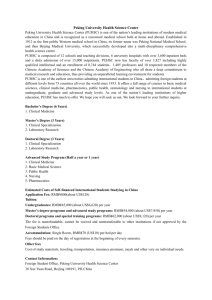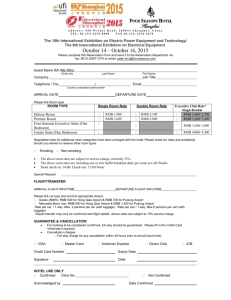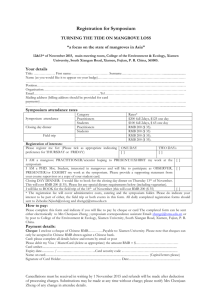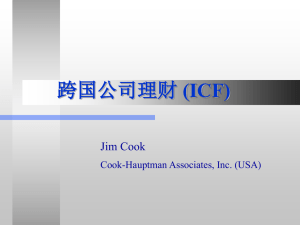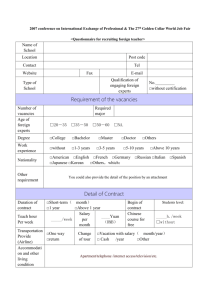A market-‐based RMB. What does it mean for China and
advertisement
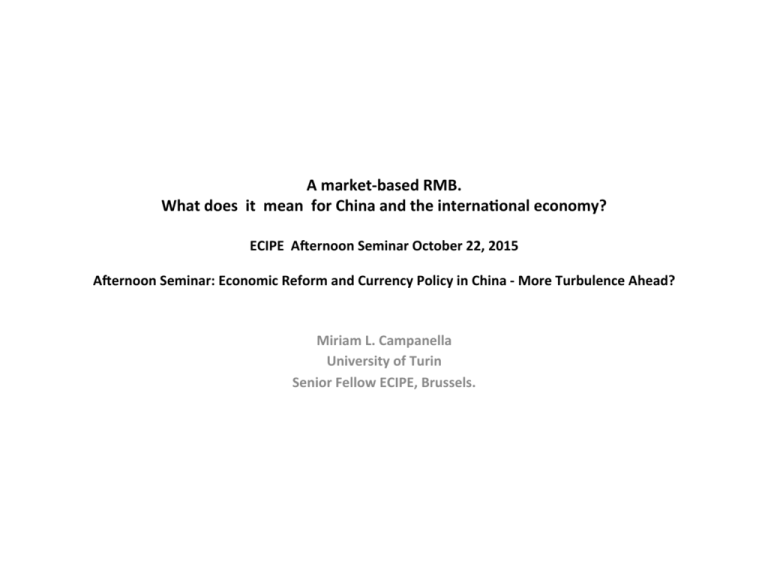
A market-­‐based RMB. What does it mean for China and the interna8onal economy? ECIPE A@ernoon Seminar October 22, 2015 A@ernoon Seminar: Economic Reform and Currency Policy in China -­‐ More Turbulence Ahead? Miriam L. C ampanella University of Turin Senior Fellow ECIPE, Brussels. August surprise move. Introduc8on • On August 11th, Chinese authori2es surprised the global financial markets, by unilaterally devaluing the yuan against the US dollar, without any advance communica2on. • In two days, Beijing quickly engineered a 3% devalua2on of the yuan in a “one-­‐off” opera2on, sending various financial markets around the world into a panic. China’s Surprise Move Devalua3on Shock One year currencies devalua3on against the US Dollar (source: Graphic Tal Yellin/CNN Money). The RMB compe33veness hypothesis. • “Abandoning the US peg and allowing the devalua3on of the RMB is just the right thing to do” (Guonan Ma 2015) • Among the G5 currencies, RMB real effec8ve exchange rate showed sizable apprecia8on (35 percent) from 2007 to mid-­‐2014. • Meanwhile, the other four SDR member currencies (the dollar, euro, yen and sterling) had registered 5 percent to 15 percent real effec8ve deprecia8on. • Especially vis-­‐à-­‐vis the yen, RMB appreciated no3ceably between 2007 and 2012 un3l the start of the so-­‐called ‘Abenomics’, RMB lost compe33veness by March 2014 by 30 percent from its peak in 2011 (Alicia Garcia-­‐Herrero, 2015). The mercan3list hypothesis. A decrease in the secondary sector (the manufacturing and the construc3on sectors) which expanded 7.3 percent, is evidence that China in a sign of despera2on was ready in a campaign of “currency war”. In the mercan2list hypothesis, China would abandon the “Strong Yuan” policy, and gradually weaken RMB against the dollar, and possibly, to keep the yuan on an “even keel “with other major reserve currencies, such as the euro and the Japanese yen Yet, the China’s devalua1on too 1ny for a mercan1list trade policy. For all the fascina8on of a mercan8list hypothesis , if numbers are considered , it falls short of a strategic assessment. Nicholas Lardy of IIE of Washington wrote: ‘If they [Chinese authori8es] wanted to revert to their mercan8list trade policies, they would have moved sooner and they would have moved by a much bigger amount”. Ge;ng to the core of the August ac1ons and the SDR hypothesis. The slowdown of the manufacturing outputs, capital ouQlows, and the weakening exports sector due to price compe22veness , and last but not least IMF recommenda2ons, are mostly considered in this Presenta2on as the mo2va2ons behind the August move. • The mismatch of a RMB pegged to a strengthening dollar while a policy of lower interest rate was needed was the first cause for concern to Chinese policymakers. So, de-­‐pegging the RMB from the US$ and introduce a market-­‐based opening rate to the RMB was a move of necessity. • LeWng markets coming in would also prevent risks of RMB overshoo2ng at the September Federal Open Market CommiXee (FOMC). • Though these risks have yet not materialized, the Fed le\ the dollar rate on hold, a preemp2ve move on exchange rate would win China’s most craved objec2ve, seeing RMB gradua2ng into the SDR basket. . The role of the IMF guidance and the SDR hypothesis. In the push for the RMB inclusion into the SDR, China has led to the accelera3on of financial liberaliza3on reforms. Targeted reforms to further increase RMB conver3bility include the opening of more offshore RMB clearing centers, increasing foreign access into onshore markets (QFII and RQFII), expansion of offshore investors by residents (QDII enhancements) and the widening of the currency trading band. Interest rate framework is also being reformed with the recent introduc3on of the deposit insurance system and the relaxa3on of deposit and lending rate caps. By de-­‐pegging in August the RMB exchange rate from the US dollar, and allowing a markets’ valua3on of the RMB’s opening rate, China has clearly followed the IMF guidance, as expressed by the Informal Commiaee on the SDR Basket Review of August 4, 2015. A market-­‐based and reserve currency’s RMB. 1. On the domes1c side, gaining monetary independence is cri1cal to China’s rebalancing. PBoC would enjoy more room adjus1ng RMB rate to the country’s economic cycle. This objec1ve is especially appreciable in the current economic circumstances, as freeing RMB interest rate policy helps smoothing out predictable downsides in the country’s journey to a post-­‐ industrial economy. 2. On the interna1onal side, a market-­‐based RMB would increase trac1on on trading partners, reinforcing its role of regional anchor-­‐currency. 3. And last but not least, gradua1ng to a reserve currency RMB would help Asian central banks, major purchasers of forex reserves, to diversify their assets out of the US dollar reducing risks of “all eggs in one basket”. All in all, an exchange rate based on market valua1on and the RMB reserve gradua1on would bestow China more rate freedom, and a growing role in the Asian monetary arrangements. China’s Rebalancing. Cargo ship rever3ng home How is China Rebalancing? GDP 2013 Export-­‐led economic growth in decline. China’s exports des3na3ons can tell something about RMB rela3ve apprecia3on: vis-­‐a-­‐vis euro and yen. China’s manufacturing sector shrinking China’s Purchasing Managers Index in down trend: a signal to Chinese policymakers to accelerate on services and domes8c consump8on. An indicator of the economic strength of the manufacturing sector. The PMI index is based on five major indicators: new orders, inventory levels, produc3on, supplier deliveries and the employment environment. Over the 50 threshold it indicates expansion; under 50 contrac3on. The index measures the na3onwide manufacturing ac3vity, focusing on smaller and medium-­‐sized companies, and filling a niche that isn't covered by the official data. Purchasing Managers Index on the down trend 2014 Caixin Manufacturing PMI in China decreased to 47.20 in September from 47.30 in August of 2015 (Markit Caixin) A post-­‐Industrial China in the making? Services Sector 2012 The new driver of the China’s domes3c economy Services Sector :2013 Services Sector 2013 • China's service sector has doubled in size over the last two decades to account for about 46% of GDP. • In 2013, it surpassed China's the secondary industries for the first 3me. Within the service sector are transport, storage and post (5% of GDP), wholesale and retail trades (10%), hotel and catering services (2%), financial services (6%), real estate (6%) and mishmash of services categorized as 'other' (18%). The Services Sector: Third Quarter 2015 51 % of GDP, slowing but surely on the rise. • • In October 2015, China reported 6.9 percent GDP growth during the third quarter of 2015. Services sector expanded 8.4 per cent, outstripping both GDP growth and the country’s industrial sector, which grew 6 per cent during the same period. The services sector now accounts for 51.4 per cent of the country’s total economic output and it is about 20 per cent larger than the declining industrial sector. China rebalances. Services Sector Third Quarter 2015 Concluding Remarks. China’s Rebalancing: Hic Rhodus, Hic Salta. • • • Even is not very clear whether China is going to let its exchange rate float completely freely, there are “off radar” channels of monetary transmission in the periphery, which seem going in a different direc3on than the usually expected “herd behavior” toward US T-­‐bonds. There are evidence that EM central banks especially in Asia are star3ng redeploying large shares of forex reserves in RMB, rather than typically in US T-­‐bonds (Winkler et alii 2015). If these developments gain momentum, could the RMB escalate , even before a full-­‐fledged free-­‐floa3ng, the monetary pyramid at the top? Yet, a final warning comes to Chinese policymakers that a failure to transi3on from an economy based on export-­‐led growth to one based on private enterprise, innova3on, and consump3on is likely to bring social and poli3cal consequences. There is a risk – as Richard C. Bush of Brookings argues, “that China will peak in economic growth, before it reaches its development goals and will be the first major economy that grows old before it gets rich”(Bush 2015). References. • • • • • • • Bush Richard C. 2015 Interview October 22. The Diplomat. Garcia Herrero Alicia, Pascal Siu 2015 “The PBoC’s balancing act on the RMB: External compe33veness versus capital ouplows”. Na3xis August. IMF (2015) Review of the Method of the Valua3on of the SDR. Ini3al Considera3ons. Washington DC. August 3. Lardy Nicholas ( 2015) “China’s latest currencies ac3ons are market driven”. China Economic Watch, August 11th. PIIE. Ma Guonan 2015“The aging dollar peg: 3me for the PBC to bid it farewell”. Bruegel. Winkler Robin, Mallika Sachdeva, George Saravelos (2015) “The ‘Great Accumula3on’ Is Over: FX Reserves Have Peaked, Beware QT”. Deutsche Bank, September 1.
